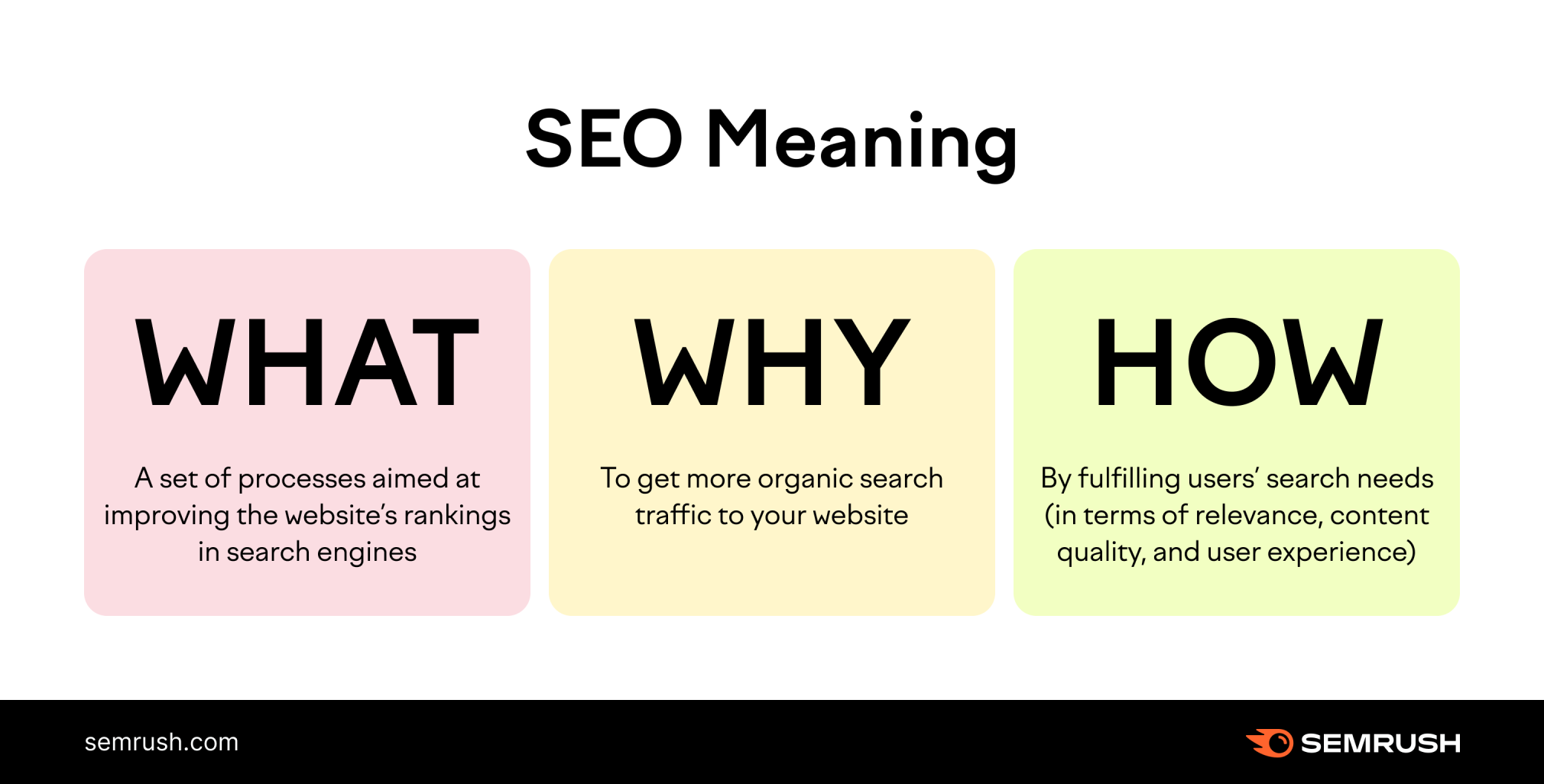Are you wondering, What does SEO stand for, what it is, and how it works? SEO, or Search Engine Optimization, is a crucial strategy for improving a website’s visibility. SEO stands for Search Engine Optimization. It is the process of improving a website’s visibility on search engines.
SEO involves optimizing website content, structure, and links. It aims to increase organic traffic from search engines like Google. Effective SEO practices help websites rank higher in search results, making them easier to find. These practices include keyword research, on-page optimization, and quality backlink building.
SEO also focuses on user experience and mobile-friendliness. Regular updates and monitoring are essential for maintaining SEO performance. Understanding and implementing SEO can significantly impact a website’s success. It is a crucial aspect of digital marketing strategies. Businesses that prioritize SEO often see higher engagement and conversion rates. Additionally, SEO helps your business by increasing online visibility, which can drive more organic traffic and lead to greater brand awareness and customer engagement.

Credit: digitalmarketinginstitute.com
Seo Components
SEO stands for Search Engine Optimization. It includes several components that help websites rank higher on search engines. The three main components are On-Page SEO, Off-Page SEO, and Technical SEO. Each plays a unique role in improving your website’s visibility and traffic. To effectively grow your SEO authority and topical expertise, it’s crucial to understand how these components work together and implement strategies that boost your site’s performance.
On-page Seo
On-Page SEO involves optimizing the content and HTML source code of a page. Key elements include:
- Keywords: Use relevant keywords in your content.
- Meta Tags: Include meta titles and descriptions.
- Headings: Use H1, H2, H3 tags properly.
- Content Quality: Write unique and engaging content.
- Images: Optimize images with alt text.
Off-page Seo
Off-Page SEO focuses on building your website’s authority. This includes:
- Backlinks: Get links from high-quality websites.
- Social Media: Share your content on social platforms.
- Guest Blogging: Write articles for other sites.
- Brand Mentions: Get your brand mentioned online.
Technical Seo
Technical SEO involves optimizing your website’s backend structure. Important aspects include:
- Site Speed: Ensure your site loads quickly.
- Mobile-Friendliness: Make your site mobile-responsive.
- XML Sitemap: Create and submit a sitemap to search engines.
- HTTPS: Secure your site with HTTPS encryption.
- Robots.txt: Use robots.txt to guide search engines.
Keyword Research
Keyword research is a vital part of SEO. It helps you find the words people use to search online. By using these words, your content can appear in search results. This increases your chances of getting more visitors.
Finding Keywords
To find the right keywords, start with brainstorming. Think about the topics related to your site. Write down words or phrases that come to mind. Use tools like Google Keyword Planner or Ahrefs. These tools show you how often people search for these words. They also show related keywords.
| Tool | Features |
|---|---|
| Google Keyword Planner | Search volume, competition, related keywords |
| Ahrefs | Keyword difficulty, search volume, related keywords |
Using Keywords
Once you have your list of keywords, it’s time to use them. Place your main keyword in the title of your page. This helps search engines understand what your page is about. Use the main keyword in the first paragraph of your content. This signals its importance.
Use related keywords throughout your content. These are words that are similar to your main keyword. They help search engines understand the context of your page. Do not overuse keywords. This is called keyword stuffing and can hurt your SEO.
- Title: Use main keyword
- First Paragraph: Include main keyword
- Body: Use related keywords
Keyword research and proper keyword usage are essential for SEO success. They help your content get found by the right people.
Content Optimization
Content Optimization is crucial for SEO success. It involves creating and refining content to rank higher on search engines. This boosts visibility and attracts more visitors to your website.
Quality Content
Quality content is the backbone of effective SEO. Search engines prioritize valuable and relevant information.
- Unique Content: Ensure your content is original and not duplicated.
- Informative: Provide useful information that answers users’ queries.
- Engaging: Write in a way that keeps readers interested.
- Updated: Regularly update your content to keep it current.
High-quality content increases user engagement. This leads to lower bounce rates and higher rankings.
Seo-friendly Formatting
SEO-friendly formatting makes your content easier to read and index.
| Formatting Element | SEO Benefit |
|---|---|
| Headings (H1, H2, H3) | Organizes content and helps search engines understand structure. |
| Short Paragraphs | Enhances readability and user experience. |
| Bullet Points | Makes information scannable and easy to digest. |
| Internal Links | Connects related content and improves site navigation. |
| External Links | Builds credibility by linking to authoritative sources. |
Proper formatting helps both users and search engines navigate your content.

Credit: www.semrush.com
Link Building
Link Building is a critical aspect of SEO. It helps improve your site’s visibility. By acquiring links from other websites, you can boost your search engine rankings. This process involves various strategies to get high-quality links. Let’s dive into the different types of links you can build.
Backlinks
Backlinks are links from other websites that point to your site. They are crucial for SEO. Search engines see backlinks as a vote of confidence. The more high-quality backlinks you have, the better your site ranks. Here are some ways to get backlinks:
- Guest blogging on reputable sites.
- Creating shareable content.
- Reaching out for link exchanges.
- Participating in forums and communities.
Ensure your backlinks come from relevant and authoritative sites. This boosts your credibility and SEO performance.
Internal Links
Internal Links connect one page of your website to another. They help users navigate your site. They also distribute link equity across your pages. Here’s how to use internal links effectively:
- Link related content within your site.
- Use descriptive anchor text.
- Ensure links are relevant to the content.
- Update old posts with new internal links.
Internal links improve user experience and help search engines index your site better. This can lead to higher rankings and more traffic.
Technical Aspects
Understanding the technical aspects of SEO is crucial. It helps search engines crawl and index your website efficiently. Optimizing technical elements improves your site’s performance and ranking.
Website Speed
Website speed is a critical factor for SEO. A fast-loading website enhances user experience. It reduces bounce rates and increases engagement. Search engines favor fast websites and rank them higher.
Here are some tips to improve your website speed:
- Optimize images by compressing them.
- Use a Content Delivery Network (CDN).
- Minimize HTTP requests.
- Enable browser caching.
- Reduce server response time.
Mobile-friendliness
Mobile-friendliness is essential for SEO. More users access the web through mobile devices. A mobile-friendly site offers a better user experience. Google uses mobile-first indexing, meaning it ranks mobile versions first.
Ensure your site is mobile-friendly by:
- Using responsive web design.
- Ensuring text is readable without zooming.
- Making buttons and links easy to tap.
- Avoiding horizontal scrolling.
- Testing your site on various devices.
| Optimization Tips | Benefits |
|---|---|
| Compress images | Faster load times |
| Use a CDN | Improved global reach |
| Minimize HTTP requests | Reduced page load time |
| Enable caching | Quicker repeat visits |
| Responsive design | Better mobile experience |

Credit: moz.com
Seo Tools
SEO tools help you optimize your website. They provide data and alerts about the overall health and success of your website. With these tools, you can see what works and what doesn’t. Let’s explore some essential SEO tools.
Analytics Tools
Analytics tools provide insights into your website’s performance. They show you how users interact with your site. Google Analytics is a popular choice. It offers detailed reports on traffic, user behavior, and conversions.
Other analytics tools include:
- SEMrush: Tracks organic keywords and backlinks.
- Ahrefs: Offers insights into competitor strategies.
- Matomo: Provides privacy-focused analytics.
Using analytics tools, you can make data-driven decisions. This helps improve your website’s performance.
Keyword Tools
Keyword tools help you find the best keywords for your content. They show search volumes and competition levels. Google Keyword Planner is widely used. It provides keyword ideas and traffic estimates.
Other keyword tools include:
- Ubersuggest: Offers keyword suggestions and SEO difficulty scores.
- KeywordTool.io: Generates keywords from multiple search engines.
- Long Tail Pro: Focuses on finding long-tail keywords.
With keyword tools, you can optimize your content for the right keywords. This improves your search engine rankings.
Measuring Seo Success
Understanding how to measure SEO success is crucial. This helps you know if your SEO efforts are working. You need to track various metrics and adjust your strategies accordingly.
Tracking Metrics
Tracking metrics is essential for evaluating SEO performance. Here are some key metrics to focus on:
- Organic Traffic: The number of visitors from search engines.
- Keyword Rankings: Your site’s position for specific keywords.
- Click-Through Rate (CTR): The percentage of users who click on your links.
- Bounce Rate: The percentage of visitors who leave without interacting.
- Conversion Rate: The percentage of visitors who complete a desired action.
To get a more in-depth understanding of how to track these metrics effectively, check out our post on the 10 best rank tracker tools. These tools can help you monitor your site’s performance and make data-driven decisions to improve your SEO strategy.
Adjusting Strategies
Once you have the metrics, adjust your strategies based on the data.
Organic Traffic is low? Improve your content quality.
Keyword Rankings dropping? Optimize your on-page SEO.
CTR needs improvement? Create compelling meta descriptions.
High Bounce Rate? Enhance user experience and page load speed.
Low Conversion Rate? Simplify your conversion process.
| Metric | Action |
|---|---|
| Organic Traffic | Improve content quality |
| Keyword Rankings | Optimize on-page SEO |
| CTR | Create compelling meta descriptions |
| Bounce Rate | Enhance user experience |
| Conversion Rate | Simplify conversion process |
Future Of Seo
The future of SEO holds exciting possibilities. New technologies and user behaviors will shape it. Staying updated is crucial for success.
Emerging Trends
Several trends are shaping the future of SEO. Here are some key ones:
- Voice Search Optimization: More people use voice assistants like Alexa.
- Artificial Intelligence (AI): AI impacts how search engines rank pages.
- Mobile-First Indexing: Google prioritizes mobile-friendly sites.
- Video Content: Videos engage users and improve rankings.
Long-term Strategies
Building a solid SEO strategy takes time. Focus on these long-term approaches:
- Quality Content: Always create valuable content for your audience.
- Backlinks: Earn links from reputable sites. This boosts your authority.
- User Experience (UX): Ensure your site is easy to navigate.
- Technical SEO: Optimize site speed and ensure proper indexing.
| Trend | Impact |
|---|---|
| Voice Search | Changes keyword strategies |
| AI | Improves search results |
| Mobile-First | Boosts mobile-friendly sites |
| Video Content | Engages users more |
The future of SEO is evolving fast. Adapting to these trends is essential. Stay informed to stay ahead.
Frequently Asked Questions
What Is Seo And How Does It Work?
SEO stands for Search Engine Optimization. It improves website visibility on search engines. It involves keyword research, content creation, and link building.
How Do You Explain Seo To Dummies?
SEO stands for Search Engine Optimization. It improves your website’s visibility on search engines like Google. Better visibility means more visitors.
What Is The Main Point Of Seo?
SEO aims to improve a website’s visibility on search engines. It helps attract organic traffic and enhances user experience.
How Do You Explain Seo To Someone?
SEO stands for Search Engine Optimization. It improves a website’s visibility on search engines. This drives more organic traffic.
Conclusion
SEO is essential for online visibility and success. By understanding its principles, you can improve your website’s ranking. Implementing effective SEO strategies attracts more visitors and enhances user experience. Stay updated with SEO trends to maintain a competitive edge. Embrace SEO, and watch your online presence grow.











Leave a Reply